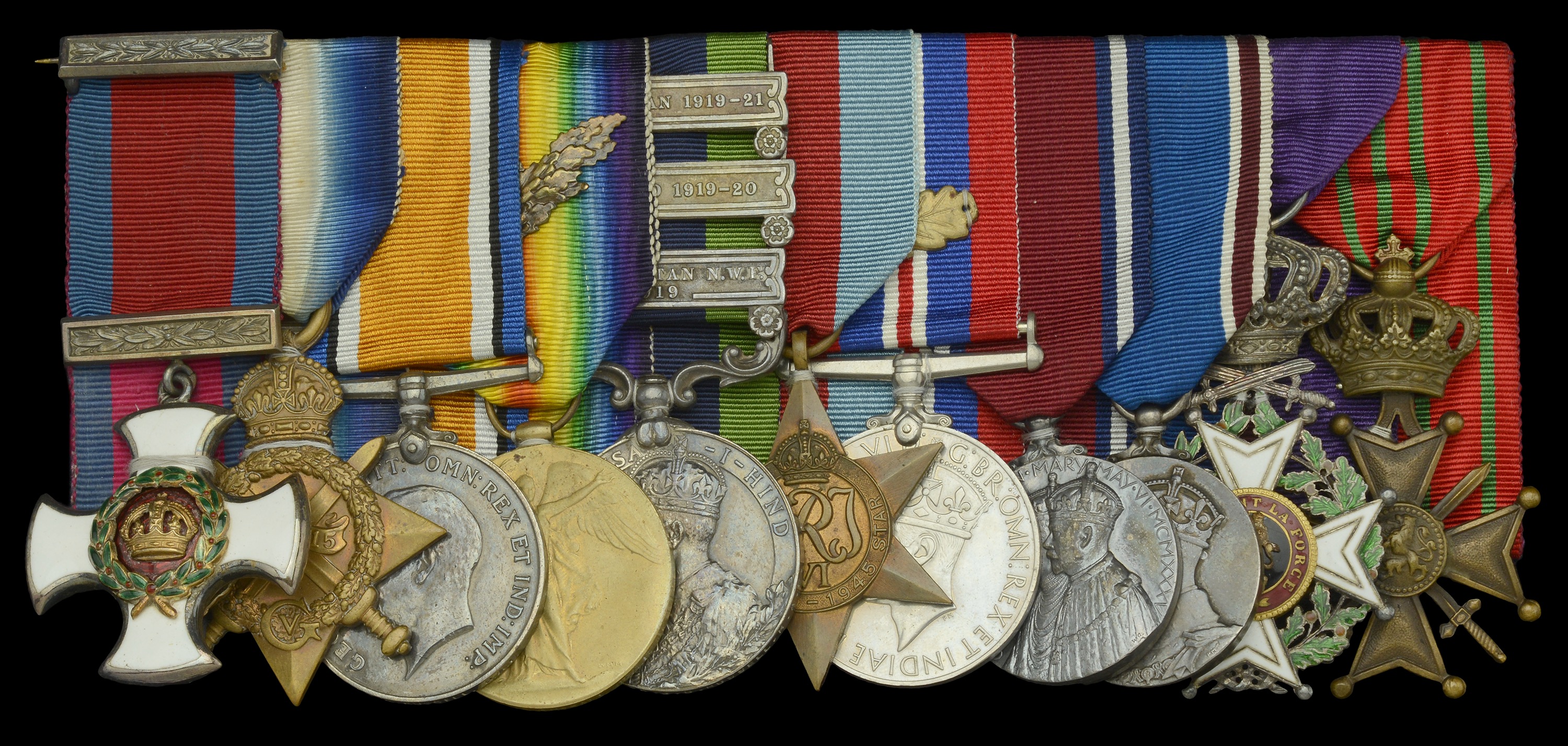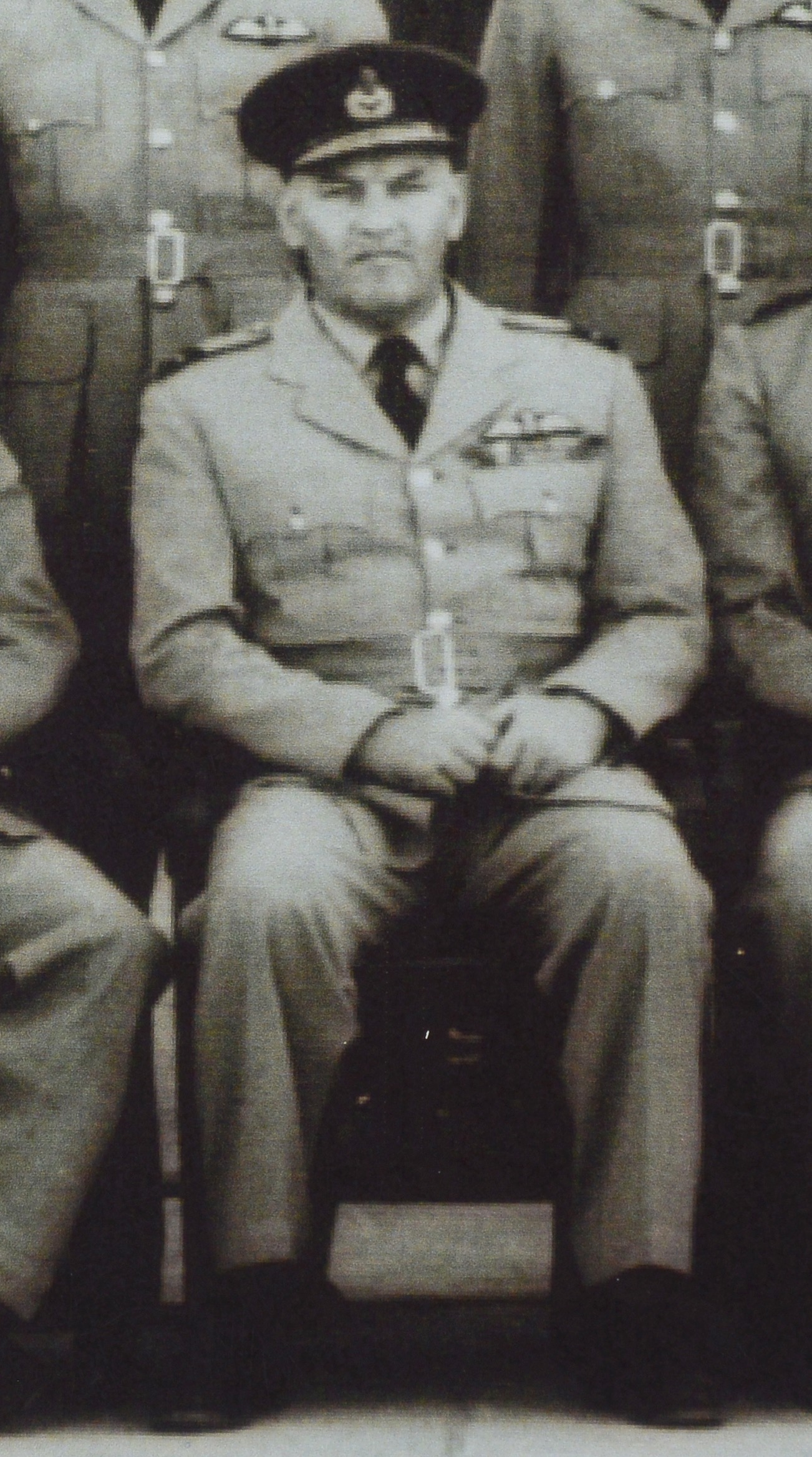67
A very fine Great War fighter squadron commander's D.S.O. group of eleven awarded to...
Bids do not include VAT, buyer’s premium or delivery.
By confirming your bid, you agree that you have read and accepted the-saleroom.com and the auctioneer's terms and conditions. Confirming your bid is a legally binding obligation to purchase and pay for the lot should your bid be successful.
Choose one of the quick bid options below:
Bids do not include VAT, buyer’s premium or delivery.
By confirming your bid, you agree that you have read and accepted the-saleroom.com and the auctioneer's terms and conditions. Confirming your bid is a legally binding obligation to purchase and pay for the lot should your bid be successful.
During Russell’s time with 32 Squadron, ‘he has personally led numberless patrols over the enemy lines, and it is entirely due to the fact that while flying, he has devoted his time to protecting and training his younger pilots rather than destroying Enemy Aircraft that he has not received an immediate award. To the qualities of leadership with which he has shown himself to be equipped are largely due to the success of his Squadron as a fighting unit.’ Russell continued with this ethos during his time commanding 20 Squadron on the North West Frontier in 1919, returning to this theatre for the Second World War when he served as Air Officer Commanding, North West Frontier (No. 1 (India) Group)
Distinguished Service Order, G.V.R., silver-gilt and enamel, with integral top riband bar, obverse centre loose; 1914-15 Star (2. Lieut. J. C. Russell. R.E.); British War and Victory Medals, with M.I.D. oak leaves (Major J. C. Russell. R.A.F.); India General Service 1908-35, 3 clasps, Afghanistan N.W.F. 1919, Mahsud 1919-20, Waziristan 1919-21 (Sqdrn. Leadr. J. C. Russell, R.A.F.) 2nd and 3rd clasps loose on riband, as issued; 1939-45 Star; War Medal 1939-45, with M.I.D. oak leaf; Jubilee 1935, unnamed as issued; Coronation 1937, unnamed as issued; Belgium, Kingdom, Order of Leopold, Knight’s breast badge, with swords, silver and enamel; Croix de Guerre, A.I.R., bronze, mounted for wear, housed in custom made Gieves, Ltd case, lid embossed in gold lettering ‘Air Commodore J. C. Russell. D.S.O.’, toned, generally very fine or better (11) £3,000-£4,000
---
D.S.O. London Gazette 3 June 1919:
‘No. 32 Sqn, R.A.F. - This officer is an extremely successful Squadron Commander, and has done very fine work as such over a period of 15 months. In addition to this, he has seen a considerable amount of Flying Services during previous periods. In order to maintain the morale of this squadron at a high standard, he has personally led numberless patrols over the enemy lines, and it is entirely due to the fact that while flying, he has devoted his time to protecting and training his younger pilots rather than destroying Enemy Aircraft that he has not received an immediate award. To the qualities of leadership with which he has shown himself to be equipped are largely due to the success of his Squadron as a fighting unit.’
M.I.D. London Gazette 1 January 1916 (France), 11 July 1919 (France), 10 June 1921 (Waziristan), 17 December 1942 (Waziristan) and 25 November 1943 (Waziristan).
Belgium, Order of Leopold, Chevalier London Gazette 24 September 1917:
‘For devotion to duty. This Officer has shown the greatest skill and courage as an Offensive Patrol Leader and sets a splendid example to his flight. He has led forty Offensive Patrols, including 3 Balloon attacks. On the 24th April, east of St. Quentin, he, single handed, attacked five enemy machines, bringing one of them down.’
Croix de Guerre London Gazette 11 March 1918.
Russell was also unsuccessfully recommended for the award of a C.B. or C.B.E. in the New Year Honours List of 1943. The recommendation (AIR2/8909) states:
‘Air Commodore John Cannan Russell, D.S.O. - This officer is in command of No. 1 (Indian) Group. He has run the Group in a most commendable manner in spite of many difficulties. He has taken the keenest interest in all aspects of his work, and the operations he has planned have been marked by thoroughness and a clear appreciation of the considerations involved. He has had an excellent liaison with the Governor of the North West Frontier Provinces who has remarked on the efficiency of his work.’
John Cannaan Russell (middle name often recorded as ‘Cannon’ or ‘Cannan’) was born in Balmaghie, Kircudbright, Scotland in March 1895. He was the son of William Russell, J.P., and was educated at Fettes College, Edinburgh. Russell was commissioned Second Lieutenant in the Scottish Signals Company, Royal Engineers in August 1914. He served with the Company in the French theatre of war from 18 February 1915, before transferring to the Royal Flying Corps in November of the same year. Russell initially trained as an Observer, being being appointed Flying Officer (pilot), 1 April 1916. After a short spell as an instructor at the Central Flying School, Russell was posted for operational flying as a Temporary Captain and Flight Commander with 54 Squadron (Sopwith Pups) at Castle Bromwich in November 1916. He moved with the Squadron to St. Omer, and then to Bertangles at the end of December 1916. The Squadron were engaged in fighter and escort missions, as well as low-level attacks on troops and transport.
Russell led his Flight on at least 40 offensive patrols, and shot down at least one enemy aircraft during his time with 54 Squadron. He advanced to Temporary Major and was appointed to command 32 Squadron (S.E.5A’s) at Droglandt in September 1917. Russell led his Squadron on fighter and ground-attack missions until the cessation of hostilities. His D.S.O. recommendation providing an insight into how he chose to command - putting the welfare of his men above all else, including personal scores and accolades. At the time of the Armistice Russell was commanding 32 Squadron from Le Hameau, and he was subsequently attached to the British Army of the Rhine.
Russell was posted as Squadron Leader to command 20 Squadron at Bannu, India, 25 April 1919. He remained with the Squadron on reverting to Flight Lieutenant and being appointed to a Permanent Commission. The ‘Mahsud 1919’ and ‘Waziristan 1919-21’ clasps on Russell’s I.G.S. are loose on riband as issued, as they were issued some time after the medal itself. The ‘Mahsud 1919’ clasp is not confirmed on the unofficial roll of the I.G.S., which is known to be inaccurate on the early clasps in particular, but there is little doubt that Russell’s entitlement is correct. During the period of the operations he was either the commanding officer or senior flight commander and as such would have qualified for the award. Moreover, he is entitled to an oak leaf on his I.G.S., but such recognition was not approved until after the Second World War, and it would appear that he never got around to displaying it.
Russell returned to the UK, and was promoted Squadron Leader in June 1922. He attended R.A.F. Staff College, Andover in May 1923. Russell was a fine scrum half, playing for Leicester, the Barbarians and captaining the Royal Air Force Rugby Team for four consecutive seasons from 1924. He commanded 3 Squadron (Woodcocks), Manston, 1924-1926, before being posted to the Directorate of Organisation and Staff Duties, Air Ministry in May 1926. Russell advanced to Wing Commander in 1930, and was posted to the H.Q. Transjordan and Palestine in March 1930. The following month he was appointed to the command R.A.F. Amman, and advanced to Acting Group Captain in October of the same year.
Russell returned to the UK at the end of 1933, and was appointed Commanding Officer of 502 (Ulster) Squadron, Royal Auxiliary Air Force, at Aldergrove in March 1934. He was promoted Group Captain, and appointed Officer Commanding, R.A.F. Aldergrove in January 1936. Russell served in a similar c...
During Russell’s time with 32 Squadron, ‘he has personally led numberless patrols over the enemy lines, and it is entirely due to the fact that while flying, he has devoted his time to protecting and training his younger pilots rather than destroying Enemy Aircraft that he has not received an immediate award. To the qualities of leadership with which he has shown himself to be equipped are largely due to the success of his Squadron as a fighting unit.’ Russell continued with this ethos during his time commanding 20 Squadron on the North West Frontier in 1919, returning to this theatre for the Second World War when he served as Air Officer Commanding, North West Frontier (No. 1 (India) Group)
Distinguished Service Order, G.V.R., silver-gilt and enamel, with integral top riband bar, obverse centre loose; 1914-15 Star (2. Lieut. J. C. Russell. R.E.); British War and Victory Medals, with M.I.D. oak leaves (Major J. C. Russell. R.A.F.); India General Service 1908-35, 3 clasps, Afghanistan N.W.F. 1919, Mahsud 1919-20, Waziristan 1919-21 (Sqdrn. Leadr. J. C. Russell, R.A.F.) 2nd and 3rd clasps loose on riband, as issued; 1939-45 Star; War Medal 1939-45, with M.I.D. oak leaf; Jubilee 1935, unnamed as issued; Coronation 1937, unnamed as issued; Belgium, Kingdom, Order of Leopold, Knight’s breast badge, with swords, silver and enamel; Croix de Guerre, A.I.R., bronze, mounted for wear, housed in custom made Gieves, Ltd case, lid embossed in gold lettering ‘Air Commodore J. C. Russell. D.S.O.’, toned, generally very fine or better (11) £3,000-£4,000
---
D.S.O. London Gazette 3 June 1919:
‘No. 32 Sqn, R.A.F. - This officer is an extremely successful Squadron Commander, and has done very fine work as such over a period of 15 months. In addition to this, he has seen a considerable amount of Flying Services during previous periods. In order to maintain the morale of this squadron at a high standard, he has personally led numberless patrols over the enemy lines, and it is entirely due to the fact that while flying, he has devoted his time to protecting and training his younger pilots rather than destroying Enemy Aircraft that he has not received an immediate award. To the qualities of leadership with which he has shown himself to be equipped are largely due to the success of his Squadron as a fighting unit.’
M.I.D. London Gazette 1 January 1916 (France), 11 July 1919 (France), 10 June 1921 (Waziristan), 17 December 1942 (Waziristan) and 25 November 1943 (Waziristan).
Belgium, Order of Leopold, Chevalier London Gazette 24 September 1917:
‘For devotion to duty. This Officer has shown the greatest skill and courage as an Offensive Patrol Leader and sets a splendid example to his flight. He has led forty Offensive Patrols, including 3 Balloon attacks. On the 24th April, east of St. Quentin, he, single handed, attacked five enemy machines, bringing one of them down.’
Croix de Guerre London Gazette 11 March 1918.
Russell was also unsuccessfully recommended for the award of a C.B. or C.B.E. in the New Year Honours List of 1943. The recommendation (AIR2/8909) states:
‘Air Commodore John Cannan Russell, D.S.O. - This officer is in command of No. 1 (Indian) Group. He has run the Group in a most commendable manner in spite of many difficulties. He has taken the keenest interest in all aspects of his work, and the operations he has planned have been marked by thoroughness and a clear appreciation of the considerations involved. He has had an excellent liaison with the Governor of the North West Frontier Provinces who has remarked on the efficiency of his work.’
John Cannaan Russell (middle name often recorded as ‘Cannon’ or ‘Cannan’) was born in Balmaghie, Kircudbright, Scotland in March 1895. He was the son of William Russell, J.P., and was educated at Fettes College, Edinburgh. Russell was commissioned Second Lieutenant in the Scottish Signals Company, Royal Engineers in August 1914. He served with the Company in the French theatre of war from 18 February 1915, before transferring to the Royal Flying Corps in November of the same year. Russell initially trained as an Observer, being being appointed Flying Officer (pilot), 1 April 1916. After a short spell as an instructor at the Central Flying School, Russell was posted for operational flying as a Temporary Captain and Flight Commander with 54 Squadron (Sopwith Pups) at Castle Bromwich in November 1916. He moved with the Squadron to St. Omer, and then to Bertangles at the end of December 1916. The Squadron were engaged in fighter and escort missions, as well as low-level attacks on troops and transport.
Russell led his Flight on at least 40 offensive patrols, and shot down at least one enemy aircraft during his time with 54 Squadron. He advanced to Temporary Major and was appointed to command 32 Squadron (S.E.5A’s) at Droglandt in September 1917. Russell led his Squadron on fighter and ground-attack missions until the cessation of hostilities. His D.S.O. recommendation providing an insight into how he chose to command - putting the welfare of his men above all else, including personal scores and accolades. At the time of the Armistice Russell was commanding 32 Squadron from Le Hameau, and he was subsequently attached to the British Army of the Rhine.
Russell was posted as Squadron Leader to command 20 Squadron at Bannu, India, 25 April 1919. He remained with the Squadron on reverting to Flight Lieutenant and being appointed to a Permanent Commission. The ‘Mahsud 1919’ and ‘Waziristan 1919-21’ clasps on Russell’s I.G.S. are loose on riband as issued, as they were issued some time after the medal itself. The ‘Mahsud 1919’ clasp is not confirmed on the unofficial roll of the I.G.S., which is known to be inaccurate on the early clasps in particular, but there is little doubt that Russell’s entitlement is correct. During the period of the operations he was either the commanding officer or senior flight commander and as such would have qualified for the award. Moreover, he is entitled to an oak leaf on his I.G.S., but such recognition was not approved until after the Second World War, and it would appear that he never got around to displaying it.
Russell returned to the UK, and was promoted Squadron Leader in June 1922. He attended R.A.F. Staff College, Andover in May 1923. Russell was a fine scrum half, playing for Leicester, the Barbarians and captaining the Royal Air Force Rugby Team for four consecutive seasons from 1924. He commanded 3 Squadron (Woodcocks), Manston, 1924-1926, before being posted to the Directorate of Organisation and Staff Duties, Air Ministry in May 1926. Russell advanced to Wing Commander in 1930, and was posted to the H.Q. Transjordan and Palestine in March 1930. The following month he was appointed to the command R.A.F. Amman, and advanced to Acting Group Captain in October of the same year.
Russell returned to the UK at the end of 1933, and was appointed Commanding Officer of 502 (Ulster) Squadron, Royal Auxiliary Air Force, at Aldergrove in March 1934. He was promoted Group Captain, and appointed Officer Commanding, R.A.F. Aldergrove in January 1936. Russell served in a similar c...
Orders, Decorations, Medals and Militaria
Sale Date(s)
Venue Address
General delivery information available from the auctioneer
If you are successful in purchasing lot/s being auctioned by us and opt for the item/s to be sent to you, we will use the following methods of shipment:
Within the UK
If you live within the UK, items will be despatched using Royal Mail Special Delivery. This service provides parcel tracking (via the Royal Mail website) and next weekday delivery (betwen 9am and 1pm). Items delivered within the UK are covered by our insurance company. Heavy and bulky lots will be sent by courier, in discussion with the client.
Outside of the UK
If the item/s being sent are worth under £1000 in total they are sent using Royal Mail’s Signed For International service. This ensures the item must be signed for when it is delivered.
If the item/s being sent are valued at over £1000 in total they will be sent using FedEx. This service allows next day delivery to customers in many parts of the US and parcels are fully trackable using the FedEx website.
Shipping Exceptions
Certain lots such as those containing glass or sharp implements, etc., may not be suitable for in-house shipping within or outside of the UK. Please contact Noonans with any queries.
Important Information
Auctioneer's Buyers Premium: 24% (+VAT)
There is an additional charge of 4.95% (+VAT/sales tax)














